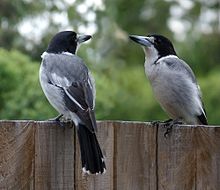Grey butcherbird
| Grey butcherbird | |
|---|---|
 |
|
| Two perching on a garden fence in Brisbane, Australia | |
| Scientific classification | |
| Kingdom: | Animalia |
| Phylum: | Chordata |
| Class: | Aves |
| Order: | Passeriformes |
| Family: | Artamidae |
| Genus: | Cracticus |
| Species: | C. torquatus |
| Binomial name | |
|
Cracticus torquatus (Latham, 1801) |
|
The grey butcherbird (Cracticus torquatus) is a widely distributed species endemic to Australia. The grey butcherbird occurs in a range of different habitats including arid, semi-arid and temperate zones. It has a characteristic "rollicking" birdsong. It appears to be adapting well to city living, and can be encountered in the suburbs of many Australian cities including Sydney and Brisbane. The grey butcherbird preys on small vertebrates including other birds.
Other birds in the same family include the Australian magpie, the currawongs, woodswallows and other members of the butcherbird genus Cracticus.
The grey butcherbird was first described by the English ornithologist John Latham in 1801 under the binomial name Lanius torquatus.
Closely related species include the silver-backed butcherbird (Cracticus argenteus) and the black-backed butcherbird (Cracticus mentalis). The silver-backed butcherbird (Cracticus argenteus) from Arnhem Land and northwestern Australia over to Port Hedland, originally described by John Gould in 1841, was later deemed to be a subspecies of the grey butcherbird. Recently, however, it has again been re-described as a separate species. The silver-backed butcherbird has two subspecies C. argenteus argenteus and C. a. colletti. The black-backed butcherbird occurs in Australia on the Cape York Peninsula and in Papua New Guinea and has two subspecies.
The grey butcherbird has three subspecies:
Various images of butcherbirds in different contexts.
...
Wikipedia

